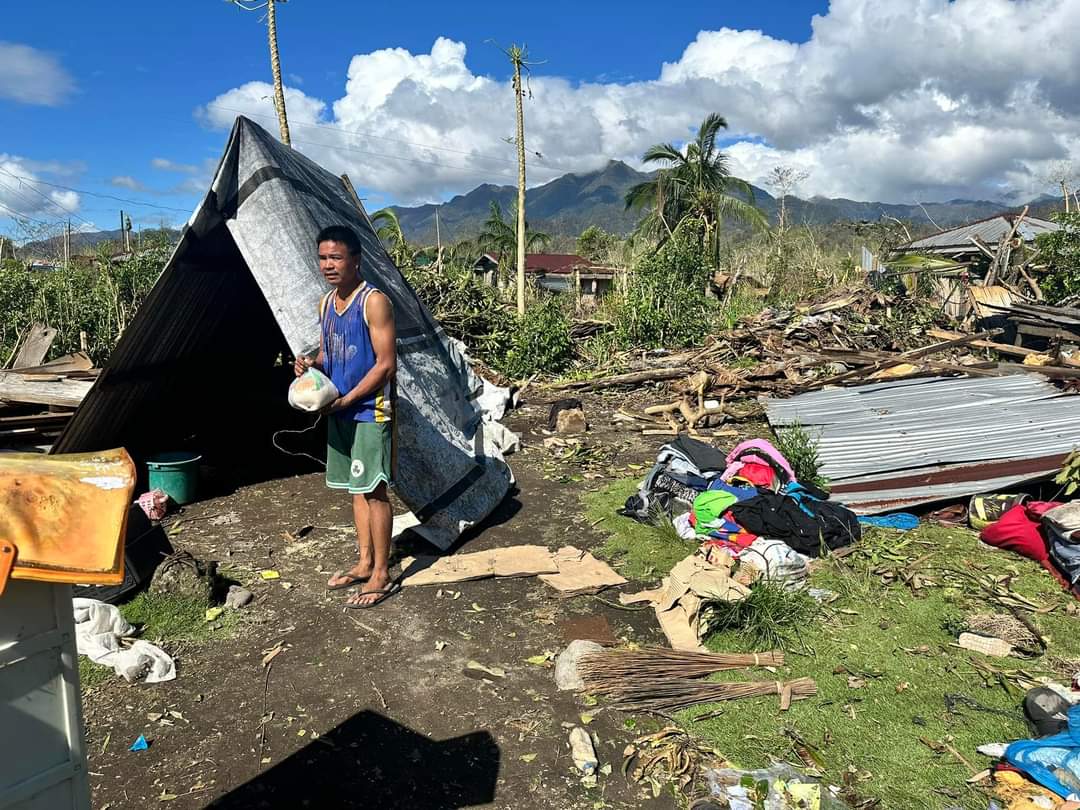Typhoon-hit Aurora under calamity state

TEMPORARY DWELLING A resident of Dinalungan, Aurora, on Tuesday checks his makeshift shelter beside what was left of the family’s house, which was destroyed by fierce winds and heavy rains brought by Super Typhoon Pepito (international name: Man-yi) as it battered northern Luzon last week. —Photo courtesy of Fr. Joefran Talaban
AURORA, Philippines — Aurora has been placed under a state of calamity due to the devastation from successive weather disturbances that hit the province last week.
The declaration made by the provincial board during its session on Tuesday cited the damage wrought by Severe Tropical Storm Nika (international name: Toraji) and Typhoon Ofel (Usagi), which pummeled the province before these battered northern Luzon.
In a statement on Wednesday, the provincial government said Nika and Ofel caused at least P410,137,000 worth of damage to infrastructure, agriculture, and tourism-related facilities in Aurora.
This, it said, does not yet include the devastation caused by Supertyphoon “Pepito” (Man-yi), which made landfall in Dipaculao town on Sunday afternoon.
Aurora is the latest area to be placed under a state of calamity due to the successive typhoons.
Article continues after this advertisementThe National Disaster Risk Reduction and Management Council (NDRRMC), in a bulletin on Wednesday, said at least 22 local governments had made the calamity declaration, among them six towns in Quirino province, two cities, and a town in Isabela, 10 towns in Mountain province, and a town each in Aurora and Ifugao.
Article continues after this advertisementThe NDRRMC also said nine died while more than 800,000 people had been affected due to the combined wrath of Nika, Ofel and Pepito.
The fatalities, it said, include seven family members who were killed after a landslide buried their house in Ambaguio town in Nueva Vizcaya province as Pepito lashed northern Luzon. Two others were reported to have died in another landslide in Asipulo, Ifugao.
The disaster response agency said four people were reported missing while 16 others were injured.
Combined reporting
The NDRRMC said its reporting of casualties for Nika, Ofel, and Pepito had been “combined,” as agreed upon by the Office of Civil Defense (OCD), the Department of Health, the Department of Social Welfare and Development, and the Philippine Atmospheric, Geophysical and Astronomical Services Administration.
Diego Mariano of the OCD Joint Information Center said that reporting of casualties for Nika, Ofel, and Pepito had been “combined, as these tropical cyclones entered the PAR (Philippine area of responsibility) consecutively” or had “entered PAR while the other is still inside… which may cause the effects of these [tropical cyclones to] overlap.”
The NDRRMC said at least 3.031 million people, or 820,131 families were affected by the three storms across 34 provinces in the country.
There were 442,857 people displaced, with 2,693 of them still staying in different evacuation centers.
According to NDRRMC, the three storms left P1.5-billion worth of damage to infrastructure and P8.6 million to agriculture.
Calamity fund use
The Aurora provincial government said around P335,469,000 in infrastructure, P51,896,000 in agriculture, and P2,772,000 in tourism-related facilities were destroyed in different parts of the province due to the Nika and Ofel that hit Aurora last week.
The declaration was proposed by Gov. Reynante Tolentino during the meeting of the Aurora Provincial Disaster Risk Reduction and Management Council on Tuesday. All members of the provincial board voted in favor of placing Aurora under a state of calamity.
With such a declaration, the provincial government can now use its calamity fund for relief operations, medical assistance, repair of damaged infrastructure and facilities, and disaster mitigation measures.
Due to the combined effects of the typhoons, some areas in the province still have no electricity, and some major roads and bridges are still not passable due to landslides, overflowing creeks and rivers, fallen debris and toppled posts.
Six structures intended to protect the communities from flooding were also destroyed.
Health centers in two villages in Dinalungan town and the municipal gymnasium in San Luis town were damaged, while at least 43 houses were destroyed and 867 were damaged in Casiguran and Dilasag towns.